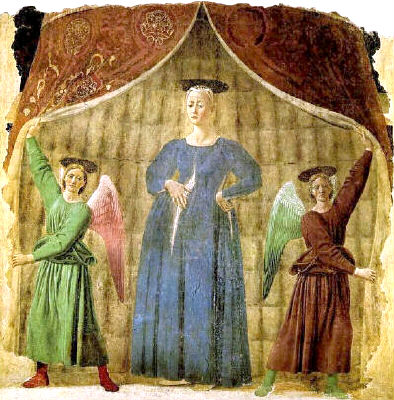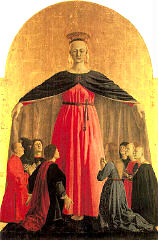Insights to Art
Piero della Francesca's Madonna del parto

Piero della Francesca, Madonna del parto - Monterchi, Tuscany

Piero della Francesca, Madonna del parto (1459 or later; 260cm x 203cm)
The Expectant Virgin
This unusual fresco by Piero della Francesca (b. 1420, d. 1492) is normally known by its Italian name, la Madonna del parto (which literally means "the Madonna of Childbirth", the word parto implying "childbirth", "delivery" or even "labour"). The very pregnant virgin is obviously only a few days away from delivery, her maternity dress not full enough to cover her very prominent abdomen. She stands - as expectant mothers sometimes do - with her left hand twisted so that her wrist supports her side, helping to give her balance and perhaps some relief. Not only does her expression seem to reveal all her discomfort, but her downward gaze also suggests she is very much aware of whose child she is carrying. In fact her right hand is obviously "protecting" the child. Her posture and expression are very natural and very human, yet at the same time the painting is highly spiritual, not least because of the presence of the two angels.
Why Such a Subject?
Piero's imposing, beautiful pregnant Madonna is the world's best known picture of an expectant virgin, there being few other paintings of the subject, except for one or two Spanish paintings on the theme. Speculation abounds as to why Piero chose to paint such a subject. Traditionally Piero is thought to have painted the picture - for a tiny countryside chapel - shortly after his mother's death in 1459, and perhaps he intended the fresco to be a tribute to his mother. Recent analysis, however, has suggested that the painting may well date from as late as 1465 or 1467. Some experts have tried to link the pregnant Madonna to local pagan fertility rites, though local superstitions associated with Piero's fresco may well derive from the painting, rather than vice versa. The repeated pomegranate motif on the drapery is, however, a clear symbol for fertility and childbearing. In many other interpretations, the drapery is believed to represent the Christian Church, while the virgin personifies the tabernacle (the container for communion bread) carrying the body of Christ.
Piero della Francesca, the Mathematician
Piero was perhaps even more interested in mathematics - especially geometry and perspective - than in art. Mathematics was his first interest, and in his later years he devoted most of his efforts to geometry (though this was in mainly due to his being blind for the last 20 years of his long life). He wrote three books, including De prospectiva pingendi on perspective in painting and De quinque corporibus regularibus on the concept of the five "perfect shapes", following in the tradition of Plato, Pythagoras and Euclid. While he concentrated on perspective in many of his other paintings, in the Madonna del parto, he is clearly exploring the idea of "perfect shapes". The whole fresco is in fact contained within a dodecahedron, while a pentagon is created by the open curtains, the angels' outstretched arms and the base of the Virgin's gown. As with his Baptism of Christ (c. 1450, National Gallery, London,) and his Madonna dell misericordia, (Madonna of Mercy, 1445, Pinacoteca Comunale, San Sepolcro), the overall original shape of the Madonna del parto fresco was probably a square surmounted by a semi-circle (the upper semi-circular section has been lost). Piero della Francesca and many other artists used these shapes in part of their quest for mathematical and artistic harmony, attempting to achieve a geometrical foundation for beauty.

Piero della Francesca, Madonna della Misericordia (1445)
The Drapery, the Angels
The other elements of the picture are not mere decorations, of course. As has already been pointed out, the drapery may well represent the Church, and its decorative pomegranate motif indicates fecundity. The drapery was originally part of a curtained canopy, presumably with a domed top. For anyone familiar with Piero's work, it immediately recalls the cloak of the powerful Madonna della misericordia painted more than a decade earlier. Just as the outstretched arms and cloak of the Madonna della misericordia enclose and protect the group of figures, the drapery of the later fresco provides a sanctuary to the Madonna pregnant with the Christ child. The angels are not only part of the overall geometrical pattern, but as heavenly representatives they also open the curtains to the world for the birth of God's son. Piero's two angels seem to emerge from the fresco along with the Madonna, but unlike the Madonna they knowingly engage the viewer's gaze, almost staring out from the painting. As part of Piero's quest for harmony, the angels of the Madonna del parto are mirror images of each other. The artist probably used the same cartoon - simply turning it over - to draw their outlines, and the colours of their clothing are likewise reversed.
The Fresco, Yesterday and Today
It is thought that Piero della Francesca painted his fresco of the Madonna del parto in just seven days in the tiny chapel of his home town. We can only imagine how impressive the tall, imposing Madonna must have appeared in the small original chapel, as a disastrous earthquake destroyed the chapel, except for the wall with the fresco, in 1785. Although Piero della Francesca was almost forgotten by that time (his frescos in the Vatican had been painted over by Raphael, for example), the Madonna del parto was moved to an unpretentious new church in the local cemetery. In 1889 the fresco was "rediscovered" as one of Piero's masterpieces and for reasons of preservation it was again detached from the damp wall. In a case of déjà-vu, it luckily escaped destruction again in another earthquake in 1917 and was moved to a new chapel built on the remains of the previous small church. Such a chequered life has taken its toll on the painting, but a careful restoration in 1993 retrieved much of its original detail and colouring, including the wonderful intense blue of the Virgin's gown. After the restoration, the fresco was placed in a protective glass case and put on display in a converted school. The modern "visitor centre" feel of the new location has caused widespread controversy in Italy and abroad.
© Nigel J. Ross, 2003
Home |
Publications |
Dictionaries |
English Lang. |
Art Insights |
Travel |
Links | ||||||